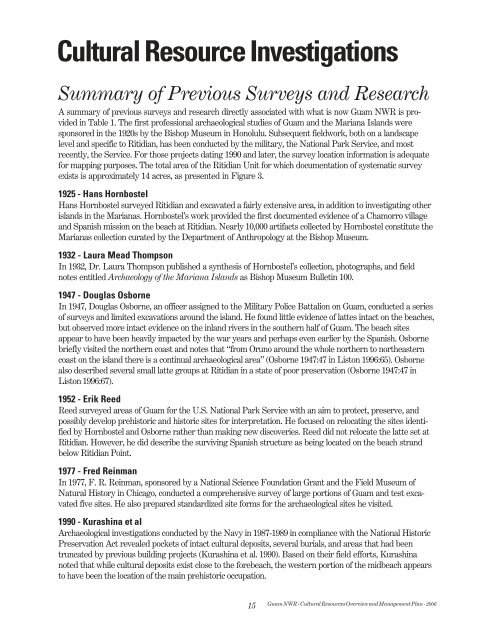Guam National Wildlife Refuge Comprehensive Conservation Plan
Guam National Wildlife Refuge Comprehensive Conservation Plan
Guam National Wildlife Refuge Comprehensive Conservation Plan
Create successful ePaper yourself
Turn your PDF publications into a flip-book with our unique Google optimized e-Paper software.
Cultural Resource Investigations<br />
Summary of Previous Surveys and Research<br />
A summary of previous surveys and research directly associated with what is now <strong>Guam</strong> NWR is provided<br />
in Table 1. The first professional archaeological studies of <strong>Guam</strong> and the Mariana Islands were<br />
sponsored in the 1920s by the Bishop Museum in Honolulu. Subsequent fieldwork, both on a landscape<br />
level and specific to Ritidian, has been conducted by the military, the <strong>National</strong> Park Service, and most<br />
recently, the Service. For those projects dating 1990 and later, the survey location information is adequate<br />
for mapping purposes. The total area of the Ritidian Unit for which documentation of systematic survey<br />
exists is approximately 14 acres, as presented in Figure 3.<br />
1925 - Hans Hornbostel<br />
Hans Hornbostel surveyed Ritidian and excavated a fairly extensive area, in addition to investigating other<br />
islands in the Marianas. Hornbostel’s work provided the first documented evidence of a Chamorro village<br />
and Spanish mission on the beach at Ritidian. Nearly 10,000 artifacts collected by Hornbostel constitute the<br />
Marianas collection curated by the Department of Anthropology at the Bishop Museum.<br />
1932 - Laura Mead Thompson<br />
In 1932, Dr. Laura Thompson published a synthesis of Hornbostel’s collection, photographs, and field<br />
notes entitled Archaeology of the Mariana Islands as Bishop Museum Bulletin 100.<br />
1947 - Douglas Osborne<br />
In 1947, Douglas Osborne, an officer assigned to the Military Police Battalion on <strong>Guam</strong>, conducted a series<br />
of surveys and limited excavations around the island. He found little evidence of lattes intact on the beaches,<br />
but observed more intact evidence on the inland rivers in the southern half of <strong>Guam</strong>. The beach sites<br />
appear to have been heavily impacted by the war years and perhaps even earlier by the Spanish. Osborne<br />
briefly visited the northern coast and notes that “from Oruno around the whole northern to northeastern<br />
coast on the island there is a continual archaeological area” (Osborne 1947:47 in Liston 1996:65). Osborne<br />
also described several small latte groups at Ritidian in a state of poor preservation (Osborne 1947:47 in<br />
Liston 1996:67).<br />
1952 - Erik Reed<br />
Reed surveyed areas of <strong>Guam</strong> for the U.S. <strong>National</strong> Park Service with an aim to protect, preserve, and<br />
possibly develop prehistoric and historic sites for interpretation. He focused on relocating the sites identified<br />
by Hornbostel and Osborne rather than making new discoveries. Reed did not relocate the latte set at<br />
Ritidian. However, he did describe the surviving Spanish structure as being located on the beach strand<br />
below Ritidian Point.<br />
1977 - Fred Reinman<br />
In 1977, F. R. Reinman, sponsored by a <strong>National</strong> Science Foundation Grant and the Field Museum of<br />
Natural History in Chicago, conducted a comprehensive survey of large portions of <strong>Guam</strong> and test excavated<br />
five sites. He also prepared standardized site forms for the archaeological sites he visited.<br />
1990 - Kurashina et al<br />
Archaeological investigations conducted by the Navy in 1987-1989 in compliance with the <strong>National</strong> Historic<br />
Preservation Act revealed pockets of intact cultural deposits, several burials, and areas that had been<br />
truncated by previous building projects (Kurashina et al. 1990). Based on their field efforts, Kurashina<br />
noted that while cultural deposits exist close to the forebeach, the western portion of the midbeach appears<br />
to have been the location of the main prehistoric occupation.<br />
15 <strong>Guam</strong> NWR - Cultural Resources Overview and Management <strong>Plan</strong> - 2006

















